How the HP Spectre Folio Beats Every Other 2-in-1 Laptop
When HP surprised us with the Spectre Folio earlier this year, we were captivated by its stunning leather-bonded chassis. Little did we know that the true magic of this laptop lies not its beauty but in how it transforms from a clamshell notebook to a tablet.
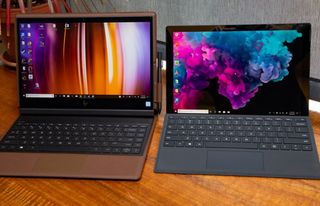
Convertible laptops were rife with problems when they first flooded the market at the turn of the decade. An op-ed penned in 2013 by Laptop Mag Editor in Chief Mark Spoonauer outlined several ways in which 2-in-1s were failing at the time. These intriguing new devices (and touch-screen laptops in general) had poor battery life, the Windows 8 operating system they ran was in an awkward transition phase and customers were forced to pay a premium for their touch-screen displays.
Fortunately, most of the issues that once plagued hybrid devices are a thing of the past. Bendback and detachable 2-in-1s are some of the longest-lasting laptops we've tested this year, with some devices enduring for more than 10 hours. The price of a flexible, touch-screen laptop has dropped as well: Microsoft's new Surface Go, a $400 detachable with a high-res display, is an example of a great 2-in-1 value, though the keyboard brings the price to at least $499.
The 2-in-1 Design Problem
But for all the progress PC makers have made to perfect the 2-in-1, the actual design of these products remains a pain point. After years of experimentation, two flavors of convertible laptops emerged: those with a 360-degree hinge and those with a detachable keyboard.
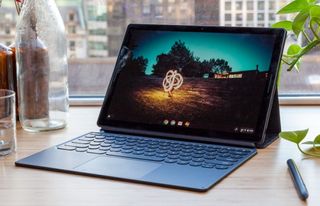
Bendback 2-in-1s, or laptops with a hinge that rotates 360 degrees, give you the best of a traditional clamshell laptop, but at the expense of the tablet experience. A compelling argument against these devices is that they are simply too large to use as everyday tablets. Even those with smaller displays, like the 11.6-inch Lenovo Flex 6 11, weighs 2.7 pounds. That may not sound hefty, but consider that the 12.3-inch Google Pixel Slate tablet weighs just 1.6 pounds. Another reason these convertible devices don't live up to the 2-in-1 bill is that they leave their keyboard exposed, making them awkward to hold in tablet mode.
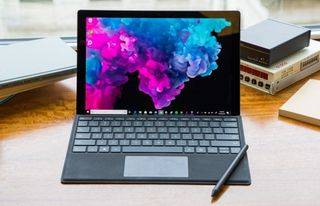
Conversely, detachables don't have the same design annoyances as their 2-in-1 counterparts. While they aren't as awkward to use as tablets, purchasing a detachable often means sacrificing comfort or performance. The Surface Pro 6, for example, has poor lapability (that is, it's difficult to use on your lap) because it relies on a flexible, detachable keyboard attachment and metal kickstand. Other renditions of a detachable laptop, like the Surface Book 2, offer a watered-down tablet experience because certain components are housed in their rigid base.
Stay in the know with Laptop Mag
Get our in-depth reviews, helpful tips, great deals, and the biggest news stories delivered to your inbox.
How the Spectre Folio Gets It Right
The Spectre Folio, a sort of hybrid between these two approaches, is the closest you'll get to a full laptop and tablet in one device. To convert the Folio to a tablet, you simply push the top of its display back, which detaches the bottom half of the screen from its thin back panel. You can then slide the bottom toward you until it lies flat against the deck. You can also stop halfway to snap the screen into presentation mode, which is also great for watching movies.
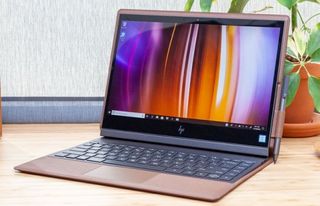
When in tablet mode, the Spectre Folio's keyboard hides safely below the display, while the back of the device remains a flat, soft leather surface. This makes the Folio more comfortable to hold in tablet mode than other detachables.
"When we started, we focused on how thin to make the leather," Kevin Massaro, vice president of consumer product design at HP, told Laptop Mag. "When you go too thin, it has a plasticky feel to it. Through many experiments, we got down to 0.7 millimeters, which was optimal for being thin but also having a plushness to it. Leather is also more comfortable from a heat dissipation standpoint. You could heat leather and aluminum to the same temperature but the leather will feel cooler to the touch."
And because you aren't actually detaching the display from the base, the Folio offers the same performance and endurance in tablet mode as it does in laptop orientation.
Folio Caveats
There is a learning curve to the Spectre Folio, but once you get the motions down, converting the device from a laptop to a tablet is more convenient than rotating a hinge or pressing down a button and detaching a display.
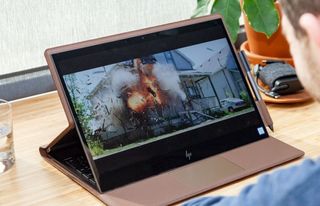
That said, the Spectre Folio isn't perfect. A 13.3-inch display still makes for an unwieldy tablet. I wouldn't want to set the device down on one of those tiny trays that airlines expect you to balance your things on. Also, holding the 3.4-pound Spectre Folio in tablet mode for an extended amount of time will make your arms feel sore. In general, laptops with 10-inch to 12-inch displays make for better tablets.
A quirk unique to the Folio is that the top half of the device sits on an extra layer of leather, which raises it above the rest of the tablet and puts the display at an angle. This had little to no impact in my day-to-day testing, but it's still worth noting that the tablet can't be viewed flat. Also, if you're not careful, you could accidentally scrape the bottom of the display against the keyboard when you're converting the laptop from one mode to another.
Bottom Line
Despite a few compromises, no other device provides a better laptop and tablet experience in one package than the Spectre Folio, and I'm looking forward to seeing others adopt — and perhaps improve upon — its innovative design.
Credit: Laptop Mag
Phillip Tracy is the assistant managing editor at Laptop Mag where he reviews laptops, phones and other gadgets while covering the latest industry news. After graduating with a journalism degree from the University of Texas at Austin, Phillip became a tech reporter at the Daily Dot. There, he wrote reviews for a range of gadgets and covered everything from social media trends to cybersecurity. Prior to that, he wrote for RCR Wireless News covering 5G and IoT. When he's not tinkering with devices, you can find Phillip playing video games, reading, traveling or watching soccer.
